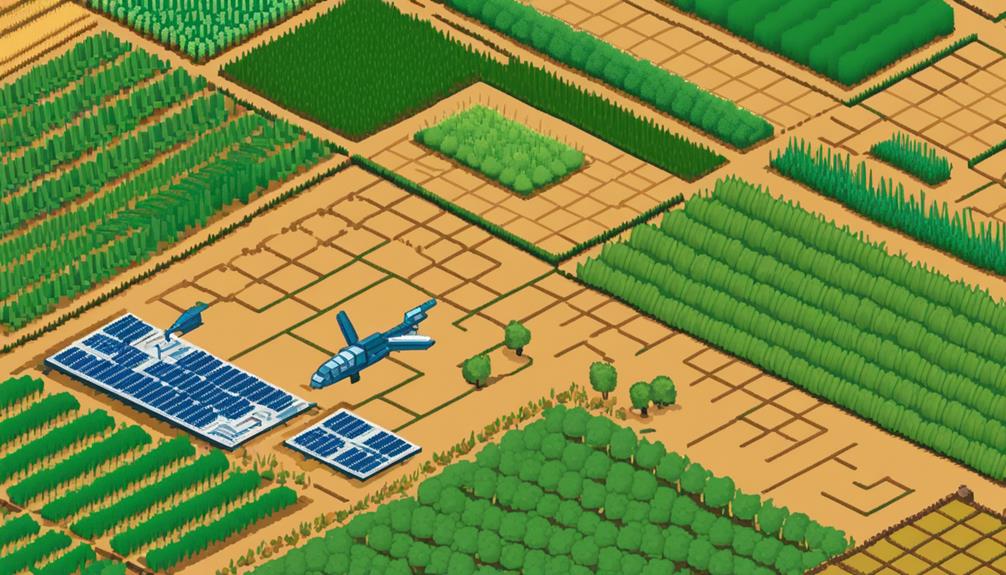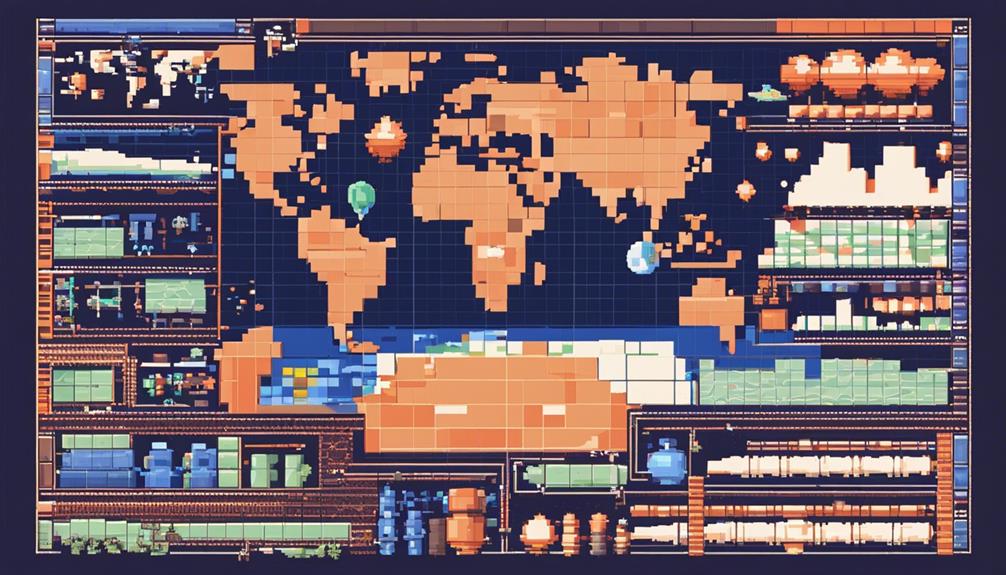Satellite swarm technology is reshaping the landscape of global connectivity by offering a cost-effective solution for various industries. The precision and efficiency of satellite swarms, like those developed by Swarm Technologies, have opened up new possibilities for applications ranging from agriculture to climate monitoring. As these satellite constellations continue to evolve and expand their capabilities, the potential for innovative solutions in remote areas and beyond becomes increasingly apparent. The intersection of technology and practical applications in satellite swarms hints at a future where connectivity knows no bounds, promising a world of endless possibilities.
Key Takeaways
- Swarm technology offers enhanced communication and data collection for comprehensive Earth observation.
- Satellite swarms provide global coverage and connectivity through distributed orbital planes.
- Precision farming benefits from real-time monitoring, optimization of resources, and global coverage.
- Future developments focus on improving swarm autonomy, coordination algorithms, and integrating advanced sensors.
Evolution of Satellite Swarms

The evolution of satellite swarms traces its roots back to pioneering research conducted at NASA's Ames Research Center, where a focus on autonomous swarm navigation for spacecraft coordination laid the foundation for the development of this innovative technology. Satellite swarms represent a paradigm shift in the way spacecraft operate in unison, offering enhanced communication capabilities and streamlined data collection processes compared to traditional individual spacecraft or constellations.
By operating as a cohesive unit, satellite swarms have demonstrated significant advantages in various missions. Projects such as Nodes and DSA have been instrumental in testing and advancing swarm coordination technologies for future space exploration endeavors. These swarms enable multi-point science measurements, autonomous responses to data inputs, and precise positioning in deep space with minimal reliance on ground control systems.
Looking ahead, upcoming missions like HelioSwarm exemplify the potential of satellite swarms for cutting-edge scientific research. HelioSwarm aims to investigate solar wind turbulence by deploying multiple small satellites to conduct simultaneous in-space measurements, showcasing the versatility and effectiveness of swarm technologies in complex and dynamic environments.
Advantages in Earth Observation
Satellite swarm technology in Earth observation offers significant advantages such as enhanced imaging resolution and global coverage capabilities. By leveraging multiple small satellites working together, swarm missions can achieve higher resolution imagery of the Earth's surface with improved detail and accuracy. Additionally, the distributed nature of swarm satellites enables broader coverage of the Earth's surface, allowing for more comprehensive monitoring and data collection across different regions.
Enhanced Imaging Resolution
Advancing imaging resolution capabilities within Earth observation missions presents a pivotal advancement for detailed monitoring of various critical aspects such as land use, natural disasters, and environmental changes. Higher resolution imagery from satellite swarms enhances precision in mapping, urban planning, and agricultural monitoring. This enhanced resolution enables better identification of small-scale features like vegetation types, infrastructure, and land cover changes. The improved imaging resolution also enhances the accuracy of remote sensing data for climate studies, resource management, and disaster response. High-resolution imagery from satellite swarms supports better decision-making in areas such as forestry, biodiversity conservation, and urban growth monitoring. Overall, the enhanced imaging resolution brought by satellite swarm technology significantly improves Earth observation capabilities for a wide range of applications.
Global Coverage Capabilities
With its comprehensive global coverage capabilities, Swarm's satellite constellation revolutionizes Earth observation missions by ensuring seamless and reliable monitoring of the Earth's surface and atmosphere. The advantages of global coverage include:
- Full Global Coverage: Swarm's satellite constellation provides fully global coverage for Earth observation missions.
- Network Connectivity: The distributed orbital planes ensure reliable and seamless global network connectivity.
- Efficient Data Collection: Swarm's small satellite design enables precise and efficient Earth observation data collection.
- Enhanced Monitoring: Global coverage capabilities of Swarm's satellites enhance monitoring and analysis of Earth's surface and atmosphere.
Swarm's satellite swarm configuration optimizes data transmission for comprehensive Earth observation applications, making it a valuable asset in the field of Earth observation.
Enabling Global Connectivity

Enabling seamless global connectivity for a myriad of industries, Swarm Technologies' satellite swarm technology revolutionizes low-bandwidth IoT applications with its cost-effective approach. Swarm's unique offering lies in its provision of the lowest-cost global satellite connectivity tailored specifically for Internet of Things (IoT) devices. This is made possible through their satellite constellation comprising 93 extra-small satellites orbiting the Earth, ensuring global coverage that is particularly well-suited for applications requiring limited bandwidth.
A key aspect of Swarm's approach to enabling global connectivity is its collaboration with Semtech, which facilitates two-way communications utilizing LoRa technology on VHF frequencies. This strategic partnership enhances the capabilities of Swarm's satellites, making them adept at catering to the needs of IoT devices operating in diverse environments worldwide.
The impact of Swarm's satellite connectivity extends far beyond mere technological advancements, reaching remote areas globally and unlocking access to crucial technology for industries such as maritime shipping, agriculture, and environmental research. By bridging the connectivity gap in these regions, Swarm's technology plays a vital role in driving innovation and efficiency across various sectors, ultimately contributing to the development and progress of industries reliant on IoT applications.
Swarm Technology Overview
Swarm Technologies' satellite swarm technology represents a groundbreaking advancement in global connectivity solutions specifically tailored for IoT applications requiring low-bandwidth communication. Swarm has positioned itself as a key player in the satellite technologies industry, offering a cost-effective network for IoT devices worldwide. Here is an overview of Swarm Technology:
- Low-cost Connectivity: Swarm Technologies provides the lowest-cost global, two-way satellite connectivity network for IoT devices, making it an attractive option for industries looking to connect their devices globally.
- Satellite Fleet: With 93 extra-small satellites in orbit, Swarm supports a wide range of industries including maritime shipping, agriculture, energy, logistics, global development, and environmental research, demonstrating the versatility of their satellite network.
- Low-bandwidth Applications: Swarm specializes in low-bandwidth use cases such as asset tracking and sensor monitoring, offering global coverage for applications that do not require high data rates, making it a suitable choice for IoT connectivity solutions.
- Cost-effective Solution: Swarm's satellite network is specifically designed to cater to industries that rely on low-bandwidth communication, providing an affordable and reliable data service globally. This focus on cost-effectiveness makes Swarm Technology a competitive option in the market for IoT connectivity solutions.
Novel Applications in Agriculture

Swarm satellite technology revolutionizes agriculture by offering precise monitoring of crop health, facilitating real-time insights into soil moisture levels, and empowering farmers to make data-driven decisions. Through this technology, precision farming benefits from enhanced irrigation optimization, ensuring efficient water usage and targeted application of fertilizers. The integration of Swarm technology in agriculture marks a pivotal advancement towards sustainable farming practices and the promotion of higher crop yields through precision agriculture techniques.
Precision Farming Benefits
Utilizing satellite swarm technology in precision farming applications revolutionizes agriculture by providing real-time monitoring and detailed insights into crop health, soil conditions, and weather patterns, ultimately optimizing farming practices for increased productivity and sustainability. This technology offers various benefits:
- Real-time monitoring of crop health and growth patterns.
- Optimization of irrigation and fertilizer usage for increased crop yields and cost savings.
- Detailed insights into soil conditions, pest infestations, and weather patterns.
- Integration with IoT devices enabling automated farm equipment control and remote monitoring of agricultural operations.
Precision agriculture applications of satellite swarm technology support sustainable farming practices and environmental stewardship.
Crop Health Monitoring
Enabling real-time monitoring and analysis of crop health, satellite swarm technology offers novel applications in agriculture that enhance precision farming practices. Swarm satellite technology provides farmers with valuable data for optimizing irrigation and fertilizer use, ultimately leading to increased yields. By leveraging Swarm's low-cost connectivity, precision agriculture practices become more accessible to farmers around the globe. The satellite imagery obtained from Swarm satellites plays a crucial role in the early detection of crop diseases and pests, allowing for prompt intervention. With Swarm's global coverage, farmers worldwide can benefit from the advanced crop monitoring techniques facilitated by this innovative technology, revolutionizing the way agriculture is approached and managed.
Irrigation Optimization
Precision agriculture practices are significantly enhanced through the utilization of satellite swarm technology for optimizing irrigation in agricultural settings. Satellite swarm technology enables real-time monitoring of soil moisture levels, allowing farmers to implement precise irrigation strategies. The connectivity provided by IoT devices facilitates remote access to irrigation data, enabling farmers to make informed decisions regardless of their location. Through satellite data analysis, farmers can adjust irrigation schedules efficiently, leading to improved water management. This optimized irrigation not only enhances crop yields but also promotes resource conservation. Swarm satellites offer a cost-effective solution for farmers in remote areas, providing them with advanced irrigation capabilities that were previously inaccessible, ultimately revolutionizing agricultural practices.
- Satellite swarm technology enables real-time monitoring of soil moisture levels.
- IoT connectivity allows remote access to irrigation data.
- Farmers can adjust irrigation schedules efficiently through satellite data analysis.
- Swarm satellites offer a cost-effective solution for advanced irrigation in remote areas.
Challenges and Future Developments

With the rapid advancement of satellite swarm technology, overcoming the challenges and shaping future developments is imperative for maximizing the potential of coordinated satellite operations. Satellite swarm technology faces several challenges that need to be addressed for enhanced efficiency. One such challenge is optimizing communication between swarm members to facilitate coordinated operations effectively. Future developments in this field are focused on improving swarm autonomy, which involves enabling real-time decision-making and adaptive behavior within the swarm.
Enhancements in swarm coordination algorithms play a crucial role in ensuring efficient data collection and transmission among satellite swarm members. By integrating advanced sensors and AI algorithms, the capabilities of satellite swarms can be significantly enhanced, allowing for a broader range of applications and more sophisticated operations. Additionally, addressing power constraints is a key area of focus for the future development of satellite swarm technology to ensure sustainable and long-term operation of these swarms.
Satellite Swarm Deployment Strategies
Satellite swarm deployment strategies encompass the systematic arrangement of satellites in various formations to optimize coverage, data relay efficiency, and redundancy for mission success. When deploying satellite swarms, several strategies can be employed to ensure the overall effectiveness of the mission:
- Formation Variety: Satellite swarms can be deployed in diverse formations such as linear arrays, clusters, or dispersed patterns based on the specific mission requirements. Each formation offers unique advantages in terms of coverage and data relay capabilities.
- Dynamic Adjustments: Swarms have the flexibility to adjust their formations dynamically during the mission to optimize performance. This adaptability ensures that the satellites can respond effectively to changing scenarios and operational needs.
- Formation Control Algorithms: Precise positioning and coordination among swarm satellites are achieved through advanced formation control algorithms. These algorithms enable the satellites to maintain the desired formation, enhancing overall mission efficiency.
- Adaptive Strategies: Adaptive deployment strategies are crucial for ensuring continuous coverage and data collection in various scenarios. By adapting to environmental changes and mission demands, satellite swarms can maintain optimal performance throughout their operation.
Impact on Climate Monitoring

The integration of swarm satellite technology significantly enhances the monitoring capabilities for climate-related indicators and phenomena. Satellites in low Earth orbit play a crucial role in climate monitoring by providing high-resolution data on various environmental parameters. Swarm satellite technology enables the observation of key climate change indicators such as sea surface temperatures, ice melt rates, atmospheric conditions, and deforestation patterns with unprecedented accuracy and frequency.
By deploying satellite swarms, researchers can access real-time information on greenhouse gas emissions, natural disasters, and other essential factors affecting the climate. These satellites offer global coverage, allowing continuous monitoring of environmental changes and their impacts on climate systems. The data collected by satellite swarms serve as valuable inputs for climate modeling, forecasting, and policy-making initiatives.
Furthermore, the use of satellite swarms in climate monitoring enhances data accuracy, coverage, and accessibility for scientists, policymakers, and stakeholders. This technology enables a comprehensive understanding of climate dynamics and trends, facilitating informed decision-making to address the challenges posed by climate change. Overall, satellites in low Earth orbit, integrated into swarm configurations, represent a powerful tool for observing and analyzing climate-related phenomena on a global scale.
Frequently Asked Questions
What Is Swarm Satellite Used For?
Swarm satellites are utilized for a range of critical applications such as environmental monitoring and disaster response, as well as precision agriculture and urban planning. Their ability to provide global connectivity for IoT devices makes them indispensable in ensuring efficient data collection and analysis for diverse industries. These satellites play a crucial role in supporting real-time decision-making processes and enabling effective resource management in various sectors.
Is Swarm a Starlink?
Swarm and Starlink are distinct entities in satellite communication. While both operate in this sphere, Swarm focuses on low-cost global IoT connectivity, offering two-way communication for IoT devices. On the other hand, Starlink provides broader internet connectivity services. The key difference lies in their target markets; Swarm caters to IoT applications, emphasizing cost-effective solutions, while Starlink aims for a wider internet user base.
What Are the Uses of Satellite Technology?
Satellite technology serves multifaceted purposes, primarily enabling space exploration and fostering robust communication networks. Through satellites, we achieve enhanced global communication, weather forecasting, scientific research, national security, and navigation systems. These satellites orbit the Earth, providing critical data and connectivity for various industries, governments, and individuals worldwide. They play a pivotal role in advancing technology, ensuring seamless communication, and aiding in the exploration and understanding of our universe.
What Are the Real Life Applications of Satellites?
Satellites have diverse real-life applications, including remote sensing for environmental monitoring and disaster management. They aid in precision agriculture by monitoring crop health and predicting yields. Satellites provide crucial data for disaster response coordination and damage assessment. Additionally, they support navigation through GPS satellites for transportation and emergency response systems. Satellites play a key role in environmental monitoring by tracking changes in land use, deforestation, pollution levels, and climate patterns.
